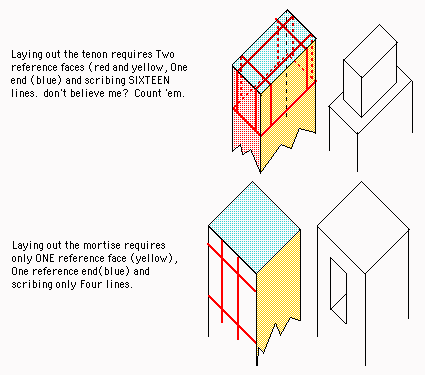Which Came First - The Chicken or The Egg? Mortise First or Tenon First?
There's a limited number of ways of making rectangular holes - mortise chisel them out, drill then chop then pair them out or use a mortising machine. OK, so you can do them with a router too, and yes there's always the Leigh FMT Expenso- Costo Jig thing. But there's a boat load of ways to cut tenons - tenon saw and chisels, table saw nibbling, radial arm saw nibbling, dado blade one pass per face, tenon jigs availale from every table saw manufacturer, router jigs up the kazoo, You can even do them with a shaper as well as with a router table with a Router-Raizer top and precision fence. There are three or four shoulder planes designed specifically to trim one or more faces of a tenon, a see through shaving at a time. A rabbet / block plane will do the job as well.
It's also easier to cut something to fit into a hole, than it is to cut a hole to fit something. Shimming a mortise or paring one or two faces is a lot more difficult than doing the same things on a tenon. Can't plane the faces of a mortise no matter what kind of hand plane you have.
Another reason for doing the mortises first - they're usually cut into the bigger, thicker, longer, more expensive pieces of wood. Do them first while you're fresh. There are exceptions of course - like on the tenons on the long rails of a bed. Personally I'd do those with loose tenons - mortise in both parts and a separate piece of wood for the loose tenon.
Mortises are also easier to lay out - only four scribe lines on one face of the stock and only three of those lines are critical - the start, the end and one side - the mortising chisel will take care of the width . To layout a tenon you need to scribe on FOUR faces and one end
